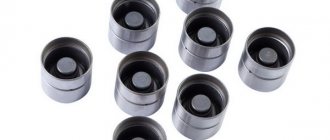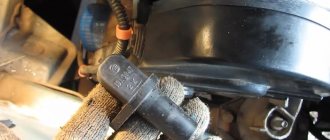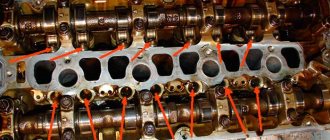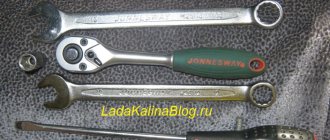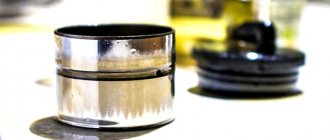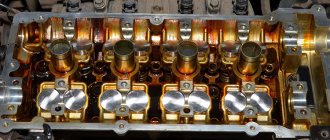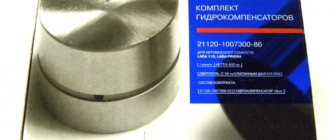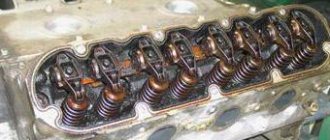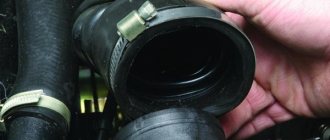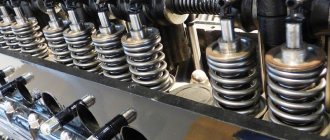The knock of hydraulic compensators on the 16-valve VAZ 2112 engine is distinguished quite simply, and determining the cause is not difficult. So, you can eliminate the cause of the knocking in a fairly simple and proven way.
Video about replacing hydraulic compensators, it shows possible causes of knocking:
The video story will tell you how to replace hydraulic compensators, as well as diagnose them in case of extraneous knocks and sounds.
Purpose and principle of operation of hydraulic compensators
Hydraulic compensators, or hydraulic compensators, are an integral part of the gas distribution mechanism (GRM) system in an internal combustion engine cylinder. When the engine warms up, timing parts heat up, which leads to an increase in their size. Therefore, thermal gaps are left between the timing parts - from 0.15 mm on the intake valves and up to 0.35 mm on the exhaust valves. One of the problems of the timing belt is mechanical wear and increase in valve clearances, as a result of which the valves do not open or close completely. The result of this is a decrease in vehicle power, difficulty starting the engine and increased exhaust toxicity. The reason for this is fuel combustion in the intake manifold or insufficient filling of the engine cylinders with the fuel mixture. Diesel cars, as a result of the incorrect size of thermal gaps, become completely inoperable.
To regulate valve clearance sizes, mechanical adjustment of levers and washers was previously used, then mechanical pushers appeared, and on modern cars they were replaced by hydraulic compensators. Hydraulic compensators automatically change their length to a size equal to the thermal gap in the timing belt.
In terms of its design, the hydraulic compensator is:
The operation of the hydraulic compensator consists of several stages.
The main advantage of hydraulic compensators is a completely automatic operating mode that does not require adjustment, since the hydraulic compensator always selects the required gap.
Consequences of knocking
Of course, you can drive with such a knock, but there is a golden rule of car enthusiasts, which states that “any small knock always grows into a big problem . And this is really, really true. Violation of valve clearances leads to a reduction in the service life of the gas distribution mechanism, as well as a deterioration in the dynamic characteristics of the car. Naturally, this will happen slowly and imperceptibly, but the general recommendation for each case is the same - contact a specialized car repair and maintenance service as soon as possible.
Symptoms of hydraulic lifters malfunction
The main sign of a faulty hydraulic lifters is the appearance of a mechanical knock immediately after starting the car engine. The knocks are localized at the location of the valve cover. If knocking does not appear immediately after starting the engine, but as it is running, then the cause of the knocking is not a breakdown of the hydraulic compensators.
Depending on the type of malfunction, knocking noises may be constant, or their level decreases or increases as the load on the engine changes. A knocking noise only on a cold engine is not always a consequence of a faulty hydraulic lifters; it may well be caused by low oil viscosity.
Troubleshooting methods
In specialized services, the cause of the knocking is determined using acoustic diagnostics. The same method allows you to identify a faulty hydraulic compensator, and there is always one. So is it possible to find it without resorting to the help of professionals?
Acoustic engine diagnostics
It is possible if you disassemble the motor. Of course, it does not need to be completely disassembled. It is enough just to remove the valve cover and try to push through each device. When pressing on the working hydraulic compensator, you have to apply some force. The faulty piston is the one that retracts when pressed lightly. There is no other way to identify a knocking hydraulic compensator.
It should be noted that if extraneous noise appears while the engine is warming up, it is not recommended to operate the vehicle. In this case, it is necessary to entrust the iron horse to the caring hands of professionals. If this is not possible, you can try to fix the problem yourself.
To do this, perform the following operations:
- the oil and oil filter are changed;
- The channels are washed to remove old lubricating fluid.
Recommendations for choosing oil
The brand of motor oil must be selected following the recommendations of the plant where the car came off the assembly line. But the seasonality of operation must also be taken into account. When the engine heats up, the viscosity of the lubricant decreases. To ensure the same lubricant characteristics, a thicker liquid is poured in the warm season, and a thinner liquid in the cold season.
Recommendations for choosing engine lubricants
If the knocking does not stop after the engine warms up, you need to check the filter. Over time, the filter element becomes clogged with foreign particles, which prevent the lubricant from penetrating the hydraulic compensators. In this case, it is necessary to replace the filter.
Pistons can knock when cold if low-quality lubricant is used, which contributes to contamination of the channels. This problem can be eliminated by removing the expansion joints and washing them in gasoline. The devices must be removed one at a time and then installed in the same sequence.
How to replace an element
If all the previous methods have been applied, but the desired results are not achieved, the knocking hydraulic compensator must be replaced with a new one. To do this, remove the valve cover, the sprocket from the camshaft and check the tensioner. Then they remove the bed and take out the pushers, strictly observing the sequence. They take out the compensators and lay them out in the same way.
Now you can start cleaning the lubrication system and the piston installation sites. After cleaning, new elements are inserted there, using a torque wrench to screw in. The last step will be installing the remaining parts.
Location of hydraulic compensators
Checking hydraulic compensators
In most cases, hydraulic lifters are checked acoustically - an experienced mechanic determines the malfunction even without using additional instruments. However, not every car owner will be able to identify a specific hydraulic compensator that is not working; moreover, knocking when they malfunction can be confused with improper operation of the engine valves.
An ordinary owner can be recommended to use a banal phonendoscope. With the engine running, the phonendoscope must be applied to the cylinder head at the location of each of the hydraulic compensators. By comparing the nature of the sound, you can determine a specific hydraulic compensator that is not working correctly.
Another method involves checking manually by pressing the device with a screwdriver or your fingers. During normal operation of the compensator, you need to make an effort to press. If the hydraulic compensator is easily pressed through, it will probably need to be replaced.
The latter method will require the use of a gap gauge with a diameter of 0.1 mm to 0.5 mm. If, on a hot engine, a probe with a diameter of 0.5 mm fits freely between the hydraulic compensator and the camshaft cam, then the hydraulic compensator must be replaced. The same applies to the situation when a probe with a diameter of 0.1 mm does not fit into the gap.
System structure
The hydraulic compensator is a cylindrical piston that transmits the force of the camshaft pusher. The internal part has a plunger that transmits force to the valve. This is what provides the thermal gap. In order for the valve to open, the piston pushes the camshaft cam, which in turn pushes through the plunger, which acts on the valve. The thermal gap is adjusted by oil under pressure. The ball valve prevents oil from leaking.
What types of knocks are there?
Hydraulic compensators can knock in different ways . These knocks need to be known to correctly determine the malfunction. We have already written in more detail about checking hydraulic compensators.
Repair of hydraulic compensators
In most cases, hydraulic compensators cannot be repaired, so they have to be replaced with new ones assembled. The exception is when the hydraulic compensator is contaminated with oil wear products. In such a situation, it is necessary to rinse the hydraulic compensator from carbon deposits and contamination, and then install it back. Before washing, it is necessary to remove the hydraulic compensators from the vehicle.
The hydraulic compensators can be washed with ordinary gasoline, kerosene, acetone or other suitable solution. After installing the hydraulic compensators, you should wait some time before starting the engine, as the devices need to compress. If the knocking stops, then the problem is solved.
Flushing expansion joints can extend their service life, but this does not mean that they will not have to be replaced later. To increase the service life of hydraulic compensators, it is imperative to use only high-quality synthetic oil.
conclusions
The reasons for the knocking of hydraulic compensators are quite simple, and their classification immediately indicates the reasons for the occurrence of this effect. The main method of troubleshooting remains a comprehensive replacement of all products.
I remember trying to install hydraulic compensators on the “six” so as not to set the valve clearances. The car immediately became dumber. A year later, during the next renovation, I removed them. And on the “twelfth” they are still working well. To avoid foam, you need to fill in high-quality oil.
I noticed that my hydraulic compensator was starting to tap, so I went to take a look. It turned out to be worn out and had to be replaced with a new one.
Sometimes you just need to change the engine oil and the knocking goes away. That is, if you change the oil at the wrong time (more than 10,000) due to dirt, let’s say they get stuck.
On a 2110 16 valve, after the engine warms up to 70′, a metallic knock or a clatter appears, and so on constantly while the engine is hot, when cold it works normally, without this clatter, what is the reason?
Yes, I'm sorry, the clatter appears in the cylinder head area where the camshafts are.
I changed the oil and the knocking does not go through the compensators
So I was hooked on this problem, the knocking of the hydraulics, whether it’s cold or hot, Lukoil Armotek 5-40 synthetic oil drove three thousand on it and one morning when they started bubbling it became scary, before that they knocked, but when the engine warmed up they stopped using the same oil. I consulted with familiar service technicians, like pour 500 ml of salya into the oil and let the engine run for 3-5 minutes on this mixture and drain it, then pour in the flushing oil and rinse. I thought that I should try just changing the oil and filter, like pour in cheap oil, run it, warm it up, and then fill it with a better one. I bought a Gasprom 10-40 and replaced the filter and oops there was a tapping sound like one gidriu and not loudly, I gave it 4000 rpm, it pumped everything up, everything became quiet, in the morning when it was cold there was no break at all and the rpm calmly began to luxuriate. Before changing the oil, while I was going to Mogaz, I turned the engine to 4500 the knocking seemed to subside and then appeared again at XX. I arrived at the garage at idle and it rattles, then it seems to disappear and the noise goes away again. I changed the oil and the rattling went away. While I'm driving around on 10-40 gas with a synthetic floor and a new Linux filter. Tolley oil... but only the filter I don’t know. But due to the increase in prices because of this virus, hydraulics cost 5400. It’s kind of expensive. Engine 21124 with mileage 273000 without capital. Oil pressure at XX 1.5-2.0 kg with increasing speed increases. So well, this engine works and let It’s working. I’ll try to measure the oil pressure on the new oil. If anything, I’ll let you know.
Additive for Liqui Moly hydraulic compensators
One way to wash hydraulic lifters without removing them from the engine is to use the Liqui Moly additive, which is designed to clean hydraulic lifters and eliminate their knocking. It is added to the engine oil every time it is changed in the car system. The additive is used for all types of engines (gasoline and diesel) with and without turbocharging. To use the additive, you must mix 300 ml (1 bottle) of the additive with 6 liters of oil when changing it. The use of an additive on old oil is possible, but only if it has been used for no more than 5–6 thousand km. At the same time, the effectiveness of using the additive on old oil decreases.
The additive helps to avoid knocking of hydraulic compensators by cleaning the valve holes and oil channels of hydraulic compensators. A positive side effect of using the additive is improving the lubricating properties of the oil.
It should be understood that the use of auto chemicals will not help in any way if the causes of knocking hydraulic compensators are associated with mechanical wear of parts. You should not expect that the additive will become a panacea for all “diseases” of a car engine. Worn hydraulic compensators or an oil pump cannot be “treated” by injecting an additive.
Problems in the oil system that can cause knocking in hydraulic compensators:
- Clogged oil channels (dirt in the channels, plaque);
- Airy oil system (air present in the system increases the compression ratio of the oil). Air in the oil can occur as a result of high or low oil levels;
- Clogged oil filter;
- The wrong oil has been filled in (does not match: viscosity, fluidity, quality, temperature characteristics);
- There may be interruptions in the operation of the oil pump;
- Overheating of the engine, as a result of which the oil burned, losing its viscous and lubricating properties.
How to check hydraulic compensators - video
Lada 2112 ᵀᴴᴱ ᴼᴿᴵᴳᴵᴺᴬᴸ › Logbook › Replacing hydraulic compensators on VAZ-2110, 2111, 2112
Hydraulic compensators (hydraulic pushers) of valves are used to automatically adjust thermal valve clearances. In essence, they are a kind of gaskets between the camshaft cams and valves, capable of changing their thickness.
Their use in the engine makes it possible not to systematically adjust thermal clearances.
The design of the hydraulic compensator consists of a cylinder-shaped body and a plunger, including a bushing, a ball valve and a spring.
The principle of its operation is as follows.
When the cam turns its blunt side towards the pusher, a gap appears between them. At this time, the spring-loaded plunger rises up, closing it, and the oil enters the plunger cavity through a channel with a ball valve. Turning the other side, the cam presses on the pusher, directing it down. The valve is closed by a ball. In this way, the plunger transmits the force of the cam directly to the valve. Malfunctions of hydraulic compensators The main indicator of failure of hydraulic compensators is their characteristic knocking sound.
It is he who signals that it is time for a replacement. There may be several reasons for this: spent resource;
premature wear of the plunger pair due to wear products entering the device; clogged oil supply channels. If the hydraulic pushers have become unusable after working for the required period, it means that the car owner paid maximum attention to the engine.
But the other two cases are a consequence of the use of low-quality, inappropriate oil, its untimely replacement, malfunctions of the oil pump or other elements of the lubrication system.
The hydraulic compensator will work ideally only when its internal space is completely filled with oil.
Otherwise, dynamic loads will gradually destroy it and they begin to knock. Replacing hydraulic compensators with your own hands The process of replacing hydraulic compensators is not difficult in itself, but you will have to work hard to implement it, because it involves dismantling the valve cover and camshafts.
The order of work is as follows. 1. Place the car on a flat surface and secure it with the parking brake.
2. Raise the hood of the car, disconnect the negative terminal.
3.Remove the engine protective cover. 4. Dismantle the receiver. We plug the inlet holes with a clean rag to prevent foreign objects and dirt from getting inside. 5. Dismantle the ignition module and crankcase ventilation hose. 6. Unscrew the bolt fixing the bracket for the injector power wires.
7. Unscrew the 15 bolts securing the cylinder head valve cover and dismantle it.
8.Having removed the cover, we check the condition of the hydraulic compensators by pressing on them from above with a screwdriver. A working hydraulic pusher should compress with great force. If significant effort is not required to compress it, the compensator is faulty. 9.Remove the drive gears from both camshafts. 10. Disconnect the oil pressure sensor connector.
11. Unscrew the 20 bolts securing the bearing housing.
12.Unscrew the nuts securing the rear shaft support bracket. 13. We dismantle it together with the bearing housing along with the spark plug guides. 14. We take out both camshafts (we put them back according to the marks) 15. To remove the hydraulic compensators from their sockets, we use a magnet. 16. We remove the old hydraulic pushers.
We install new ones in their place. 17. Installation is carried out in the reverse order, do not forget to set the camshaft marks.
18. We get rid of sealant residues at the joints with the cylinder head. We take into account the tension of the head mounting bolts. 19. Before assembly, apply special Loctite sealant to all head joints. Result of the work Having completed the installation work, we check the operation of the engine.
Immediately after starting, the engine may work, making extraneous sounds in the form of clattering or tapping. They indicate that the hydraulic compensators need to be pumped, i.e. fill with oil, expelling the air. To carry out this procedure, start the engine and run it for 5 minutes at 2500 rpm. After this, go to idle speed and wait 30 seconds. Next, turn off the engine and wait a minute.
Next time you start, listen again. If the sound does not disappear, repeat the procedure. Usually after 3-5 such pumpings the extraneous sounds disappear.
Source
Replacing the timing belt: instructions
Let us note a slight difference in the procedure for replacing the belt on a Priora with and without air conditioning. You will need to first remove the belt and tensioner pulley of the generator (not to be confused with the timing tensioner) in order to dismantle the protective covers of the drive of the timing mechanism itself.
Using a 15 mm socket, unscrew the tension roller of the generator, remove the belt itself (it is recommended to replace it together with the timing belt), access is open; Using a T-30 bit (asterisk), or a hexagon, unscrew 5 bolts of the upper cover (plastic casing) and 2 bolts of the lower timing drive cover; Disconnect the crankshaft sensor by disconnecting the corresponding chip located near the top cover; If it is necessary to replace the cooling system pump, you will have to lift the right drive wheel into the air with a jack. All this is needed to compare the marks of the camshaft pulleys with the marks on the block body; We rotate the raised wheel in 5th gear, or turn the crankshaft pulley with key number 17. Having matched the camshaft marks with the marks on the block body, it is necessary to turn on the neutral gear to avoid failure of the mark settings. Check the markings on the flywheel by removing the rubber plug at the top of the flywheel housing. Under the plug you can see part of the flywheel and the crown on it; align the flywheel mark with the triangular mark on the left side of the housing; If it is necessary to replace the pump, at this stage it is necessary to loosen the fastening of the 2 camshaft pulleys in order to avoid deformation of the valves when the gas distribution consumable is dismantled; To gain access to the crankshaft pulley, you need to turn the steering wheel as far as possible to the right or remove the wheel. You will need a helper to remove the crankshaft pulley.
Engage 5th gear, hold down the brake pedal, and use a 17mm key to unscrew the fastening bolt;
ATTENTION! Left hand thread! Remove the pulley and thrust washer. Head 15mm; unscrew the bolts securing the tension and thrust rollers, after dismantling which you can remove the timing belt
Install a new timing drive consumable. You need to apply tension by turning the tension roller with an offset center (the cutouts of the race and the tension roller bearing bushings must match). When reassembling, carefully monitor the marks on the camshaft pulleys and engine flywheel. When replacing a part, the support and tension rollers are changed immediately.
SKYLINE636 › Blog › useful information about hydraulic compensators
The hydraulic compensator, also known as a hydraulic pusher, is designed to automatically adjust the thermal clearances of engine valves. While operating the car, you can hear the engine knocking, they say it is the hydraulic compensators knocking. Do you know the causes of this malfunction and how to deal with it?
For hydraulic compensators to operate, a constant supply of oil under pressure is required. To do this, there is a channel in the cylinder head with a check ball valve (it prevents oil from draining from the channels after stopping the engine), as well as channels on the lower plane of the bearing housing (they also supply oil to the camshaft journals).
Hydraulic compensators are very sensitive to the quality of the oil and its purity. If there are mechanical impurities in the oil, rapid failure of the hydraulic compensator plunger pair is possible, which is accompanied by increased noise in the gas distribution mechanism and intense wear of the camshaft cams. A faulty hydraulic compensator cannot be repaired and must be replaced. If after replacement the new hydraulic compensators knock, this is normal, but only for a short time. If the knocking does not stop, the cause should be determined.
How to determine which hydraulic compensator is knocking?
To check the hydraulic compensator, you need to press it with a soft metal drift or a screwdriver (with the camshaft cam facing the pusher with the back of its head). In normal condition, the hydraulic pusher should be pressed with considerable force. If the force is small, the hydraulic pusher must be replaced. Install the camshaft cams one at a time with the protrusions facing up and check for clearance between the pushers and the cams. When pressing (for example, with a wooden wedge) the hydraulic pusher being tested, compare the speed of its movement with the others. If there is a gap or an increased speed of movement, disassemble the hydraulic compensator and clean its parts from dirt or replace the hydraulic compensator.
●If the hydraulic compensators knock when starting:
The cause of the malfunction is oil leakage from part of the hydraulic compensators during long-term parking. Remedy - noise that disappears a few seconds after starting the engine is not a sign of a malfunction, since some of the hydraulic compensators that were under the load of the valve springs of the open valves (the oil supply channels remained open) leaked oil, the deficiency of which is replenished at the beginning of engine operation.
●Hydraulic compensators knock when cold and hot, the noise disappears when the speed increases:
The cause of the malfunction is damage or wear of the check valve ball. Contamination of the hydraulic compensator mechanism with wear products due to untimely oil changes or poor quality.
Remedy: Replace the hydraulic compensator. Clean the mechanism parts from dirt. Use the oil recommended in the owner's manual.
●Hydraulic lifters knock when hot, the knock disappears after increasing the speed. There are no problems when the engine is cool:
The cause of the malfunction is the flow of oil through the gaps between the plunger and the hydraulic compensator sleeve, which have increased due to wear. Remedy: Replace the worn hydraulic compensator assembly.
●Hydraulic compensators knock at high speeds, but there is no knock at low speeds:
The cause of the malfunction is foaming when there is excess oil (above the top mark on the dipstick) in the oil sump due to its agitation by the crankshaft. If an air-foamy oil mixture gets into the hydraulic compensators, it disrupts their operation. Air being sucked in by the oil pump when the oil level in the oil sump is too low. Damage to the oil receiver due to deformation of the oil sump when hitting a road obstacle.
●Continuous noise of one or more valves, independent of crankshaft speed:
The cause of the malfunction is the occurrence of a gap between the pusher and the camshaft cam due to damage or contamination of the hydraulic compensator parts.
Remove the cylinder head cover, install the camshaft cams one at a time with the protrusions facing up and check for clearance between the tappets and the cams. When pressing (for example, with a wooden wedge) the hydraulic pusher being tested, compare the speed of its movement with the others. If there is a gap or an increased speed of movement, disassemble the hydraulic compensator and clean its parts from dirt or replace the hydraulic compensator.
Most often, hydraulic compensators knock due to insufficient oil level or poor quality. Don’t rush to disassemble the engine and look for the cause; try simply replacing the oil with the one recommended by the manufacturer. Another question that worries many is “is it possible to drive if the hydraulic compensators are knocking?” Answer: you can.
Source
Device
What to do if valves or hydraulic compensators on a VAZ 2112 16 valves are knocking? Before answering this question, it is necessary to understand the structure of the hydraulic compensator, which mechanics often abbreviate to “hydric”. It is from the peculiarities of its structure that the reason for some knocks follows.
The hydraulic compensator itself consists of a cylindrical piston, whose bottom receives the force from the camshaft pusher. There is a plunger located inside it. With its help, force is transmitted from the camshaft to the valve stem. The plunger moves quite freely in its seat. This is necessary to ensure a thermal gap. When the engine is running, the camshaft cam pushes the piston, which opens the valve through a plunger. The thermal gap is adjusted using oil supplied to the head under pressure. Accordingly, adjustment occurs by changing the pressure. To avoid oil leakage from the hydraulic valves during parking, a ball valve is used.
Hydraulic compensators and malfunctions in them
Let's immediately determine that the knocking of the hydraulic compensator is a problem that occurs in 90% of cases not on new cars, although exceptions are possible if a low-quality part was installed at the factory. But this is also unlikely, since the hydraulic compensator belongs to the power unit, and factories producing engines have much more stringent requirements regarding the quality of components supplied by suppliers.
Problems with knocking hydraulic compensators can arise over time on a car of any make, year and country of manufacture.
There are a number of ways to eliminate annoying sound, each of which should be used in a specific situation.
But in order to understand why the hydraulic compensator is knocking and the reason for its failure, you first need to understand what kind of mechanism it is, what it consists of, and how it functions. And in general, what can such a knock lead to, and what will happen if it is not eliminated in a timely manner.
What attracts car enthusiasts is the Lada Priora 8-valve. Engine characteristics
The heart of the car is represented by petrol power units of two versions:
- VAZ 21116, equipped with four cylinders with two valves on each;
- a more powerful VAZ 21126 engine, the basic basis for which was the VAZ 2112 engine. It uses a 16-valve mechanism with the same four cylinders.
In Priora, manufacturers have provided for the use of injection-type power units. A special exhaust gas neutralizer is located in the same housing with the exhaust manifold. In this device it is catalytic. In addition, the engine has a special fuel injection system.
Hydraulic compensator for a car - simple about complex things!
In order to understand the principle of operation of the hydraulic compensator, and therefore determine why it fails and how to repair it, you need to remember the design of the engine. Do you remember how the valves are located and what they are for? The intake valve is responsible for the supply of fuel, and the exhaust valve is responsible for the exit of gases exhausted during fuel combustion in the engine.
So, a hydraulic compensator is a device that regulates the valve clearance automatically, thus ensuring a uniform supply of fuel to the working chamber of the engine and the exhaust outlet. Installing hydraulic compensators eliminates the process of manually adjusting the valves for the manufacturer's servicemen, which, by the way, is very labor-intensive and time-consuming.
How did they appear?
The hydraulic compensator on VAZ cars has replaced ineffective mechanical adjustments of the timing mechanism.
Often a regular valve on classic VAZ engines is not equipped with a compensator. Therefore, drivers adjusted valve clearances every 10 thousand kilometers. The work had to be done manually. The valve cover was removed, measurements were taken with a feeler gauge and the required gap was set. If the driver did not adjust the valves, the engine operation was accompanied by loud noise, dynamics were lost, and fuel consumption increased. After about 50 thousand kilometers, the valves required replacement, as they were severely worn. As an alternative to mechanical adjustment, AvtoVAZ decided to offer a more modernized design.
On engines for front-wheel drive cars, special pushers were installed in front of the valve. A “hat” was put on the valve. The diameter of the pusher is large enough, and due to this, wear has been reduced. It takes longer for a larger diameter to wear out. Yes, the wear rate has decreased, but the need to adjust the valves remains, although now it has to be done less often.
Typically, tuning consisted of adding tuning washers, which decreased or increased the height of the pusher. This adjustment, despite its archaic nature, is quite effective, and some automakers use this method to this day. Valve clearances in such a mechanism need to be adjusted once every 50 thousand kilometers. On some foreign cars, pushers can live even longer.
Among the advantages of this solution are the simplicity of the design, the absence of oil requirements - even mineral oil will do. In addition, the design turned out to be very cheap. Among the disadvantages, reviews note that if the washer has worked, then the engine becomes noisy, fuel consumption increases, and dynamics decrease. AvtoVAZ thought about a design that would automatically regulate thermal clearances in the valve mechanism.
And so, instead of mechanical adjustments, VAZ-2112 hydraulic compensators appeared. At that time it was a completely new technology. In fact, everything is very simple - the driver no longer needs to manually adjust the gaps. The hydraulic compensators themselves will automatically select the desired parameter for each valve.
Why do hydraulic compensators knock?
Now let's move on to closely examining the question of where that unpleasant knocking noise from under the hood of your car comes from.
There are usually two common reasons:
1. The knocking noise occurs due to damage or destruction of the mechanical parts of the hydraulic compensator itself. 2. Knocking occurs due to a malfunction of the systems supplying oil to the engine.
Professionals even know how to identify a knocking hydraulic compensator by ear, and what exactly the problem is.
The reasons for the destruction of the mechanisms of the hydraulic compensator itself include the depletion of the service life of the plunger pair installed inside the hydraulic compensator. This happens over time, unfortunately, the process is inevitable, so replacing hydraulic compensators should be treated like replacing any automotive “consumables”. Depending on the quality of the components used in the production of the hydraulic compensator, its service life directly depends. The lower the quality of the metal, the faster it will fail. Naturally, there may also be a manufacturing defect. Also, the hydraulic compensator is damaged if air gets into it, or too little oil, or due to contamination of the hydraulic compensator parts. There are many reasons, but the result does not change - the mechanism fails and requires either cleaning, if you diagnosed the problem at an early stage, or complete replacement, if at a later stage.
Regarding problems with oil supply to the engine. A knock will occur if the oil level in the engine differs from the norm, both down and up. End of service life and failure of the oil filter. Contamination or ingress of carbon deposits into the oil channels that form during engine operation.
Choosing the wrong brand of oil. Naturally, if you overheat the engine, the physical properties of the oil will change, which will also lead to disruption of the oil supply systems.
We have already said above that knocking can occur both when the engine is cold and when the engine is warm.
On a hot engine, the presence of knocking is most likely due to the presence of oil in the engine, which is high time to change, or if you have recently done this, it means that you have come across oil of poor quality - this, by the way, is another reason to buy lubricants only from official representative offices or dealers. Filling with low-quality oil can cause engine damage much more serious than knocking hydraulic lifters.
It often happens that replacing the oil with a new one solves the problem with knocking hydraulic compensators.
If you have not changed the oil filter for a long time, then be sure to replace it, or at least clean it, for which you should use a special hydraulic compensator cleaner.
Although, according to the vehicle maintenance regulations, the oil filter is supposed to be changed simultaneously with the oil change.
If all of the above operations do not produce any results, you should consider other options for the occurrence of knocking in the engine compartment, since replacing the filter and using high-quality engine lubrication in 90% of cases helps solve the problem. Remember that a knock under the hood when the engine is warm is a critical indicator and requires urgent intervention and elimination of the cause of its occurrence.
And vice versa, if your hydraulic lifters are knocking on a car that is not yet warmed up, it is not of fundamental importance. Cold oil has different physical characteristics from hot oil and does not get inside the hydraulic compensator, so you just need to wait until the engine warms up. If the knocking persists, then you should begin to solve the problem.
Frequent VAZ problems
Let's look at the most vulnerable points of the propulsion system of VAZ cars using the Lada Priora as an example. During the operation of the Lada Priora vehicle, the car's owners identified vulnerabilities of the internal combustion engine. Owners of Lada Priora noted the lack of reliability of the liquid pump. During the operation of a modern VAZ, the function of the pump is often disrupted. As you know, a malfunction of the liquid pump can lead to serious consequences and can entail considerable monetary costs for car repairs.
Therefore, it is recommended to promptly pay attention to the temperature analyzer readings. Pump failure inevitably leads to increased load on the motor system
Overheating of the motor is a complex breakdown; it is much easier to notice a pump malfunction in time. Also, owners of Lada Priora, when trying to repair vases with their own hands, often note a violation of the radiator seal at the connection point. If traces of working fluid appear in the adhesion areas, it is necessary to promptly begin restoring the tightness of the element. Another weak point of the Lada Priora is the timing drive pulley. You can identify a malfunction of the video by noticing an uncharacteristic sound when the engine is running. In most cases, if a hum occurs, the roller should be replaced. If you encounter a malfunction of the timing roller while traveling, you should generously lubricate the element before performing maintenance. Also, a common malfunction that Priora owners encounter is oil leakage from under the valve cover. If a leak occurs, the cover seal must be replaced. The VAZ stove also often causes driver frustration in winter at low air temperatures.
Which hydraulic compensator is making the knocking noise?
To determine which hydraulic compensator is making a knock (usually their number is equal to the number of valves in your engine), they use a diagnostic method “by ear”, using a technological version of such a medical device as a phonendoscope - you have almost certainly seen it on your therapist’s neck.
It is this device that allows the master to say exactly where the source of the knocking lies, although real professionals, of course, will determine this without any phonendoscope.
After diagnosing the knocking part, you need to remove the hydraulic compensator, thoroughly clean it, then install it in place and start the engine again.
If the knocking noise persists, the hydraulic compensator is considered to be out of order, and the service will replace it.
If the knocking continues after replacement, the reason most likely lies in the quality of the oil used, or in other engine components. The latter is unlikely, since diagnosing a sound source using a phonendoscope is an accurate procedure and, as a rule, does not cause failures.
Oil is changed during maintenance for a reason
In case of prolonged operation of the vehicle without changing the oil, the following situations may arise that cause knocking of the hydraulic compensators:
- channel contamination
- oil loses its qualities
In the first case, the knocking will occur when the engine is cold. The oil supply channels are clogged and therefore it is impossible to create the required pressure in the hydraulic compensators. As the oil warms up, deposits peel off and oil flows throughout the entire system. After cooling, all the dirt will sit on the walls and re-clog the channels. This will cause a knocking noise every time the engine warms up.
If the oil has lost its qualities due to age, it may begin to foam. Such oil is not capable of creating the necessary pressure and its prolonged presence in the engine will lead to significant damage.
If the oil is old, it must be replaced. You should not immediately fill in expensive oil. It contains high-quality detergent additives that can remove dirt from the walls. This will lead to even more clogging of the oil system channels. Therefore, before filling in good oil, after prolonged use with old oil, it is necessary to flush the system with a special product.
Severe mechanical wear
If the car has high mileage and the hydraulic compensators have not been changed for a long time, knocking noise from them may be due to excessive wear.
A visual inspection will help you understand how to identify a knocking hydraulic compensator. If the impact surface is worn, the knocking hydraulic compensator will be visible immediately by the dents from the camshaft. If all the hydraulic compensators look normal outwardly, you need to press them one by one with a piece of wood or a screwdriver. The effort should be the same. In this way, you can identify both a jammed hydraulic compensator and one that is not holding pressure.
